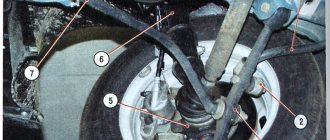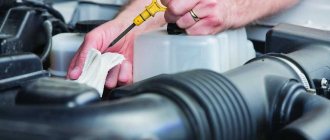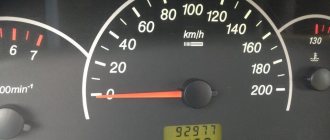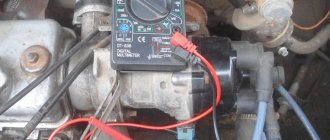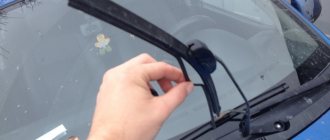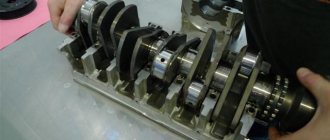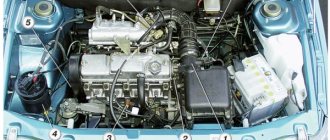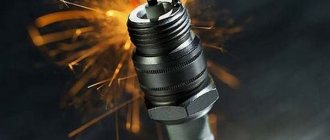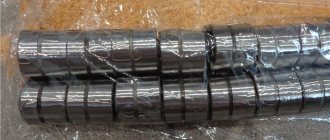Front suspension "Lada Grants"
It has an independent suspension with wishbones and a stabilizer bar. Damping of vibrations is carried out by hydraulic shock absorbers. The main structural element is the stand. It includes a swivel bearing, shock absorber and spring. The latter uses coils of variable diameter. The spring itself is made of a metal rod with a circular cross-section. It can have variable and constant hardness.
The front suspension of the Lada Granta is designed so that the lower part of the strut rests on the steering knuckle. When the wheels turn, the spring and shock absorber rotate with it. The stand itself remains motionless. Thus, the engineers achieved an increase in the service life of the elastic element while maintaining the inlet hole in the shock absorber body.
The pillar support has also been improved. Suspension creaking on the Lada Granta appears much less frequently than on Kalinas and Priors. To reduce roll, the design includes a stabilizer bar. It is made of spring steel. The stabilizer is installed with its ends to the lower suspension arms. Its middle part is fixed to the body.
Owner reviews of the Granta suspension
The opinions of motorists are largely similar. They note a number of advantages of the suspension system:
- for Russian roads it has a strong and reliable design;
- at very low temperatures it does not freeze and works out all the irregularities;
- capable of “swallowing” even deep holes without much damage;
- The car does not pull to the side at high speed when driving on the highway.
There are also disadvantages:
- the suspension is not soft and smooth;
- Unlike Logan, with which the Grant is often compared, the chassis is clearly stiffer.
In general, this is the same suspension system from the “nine” with minor changes, but for the Russian automotive industry this is a big step forward. Especially when you consider that the condition of the vehicle depends entirely on your driving style.
The unpretentiousness, simplicity and reliability of the chassis are the pride of Granta. There is one minus: the suspension with negative caster of the front wheels, front anti-roll bar and negative camber of the rear wheels is installed exclusively in modifications above the basic one - “Norma”, “Lux”. For owners of the “Standard” configuration, a suspension option borrowed from Kalina is provided.
Rear suspension
Unlike the front, it has undergone virtually no changes. Here, just like on the first Soviet G8s, a semi-independent beam is used. It is attached to the body on hinges (fortunately, there are no “crabs” in the design). A helical spring with constant stiffness is used as an elastic element. To dampen vibrations and prevent swinging, two shock absorbers are used.
The elements come from the factory are oil type. The spring is fixed together with the shock absorber. This greatly simplifies maintenance work, but has a negative impact on handling. Often the rear axle skids when cornering. But despite the archaic design, the owners speak positively about this suspension and highlight a number of advantages:
- High reliability. The design does not have additional levers, which, in addition, can bend when falling into a large hole.
- Energy intensity. The Lada Granta absorbs all bumps perfectly, especially if oil shock absorbers are installed at the rear.
- Cheap maintenance. Due to its simple design, this pendant can be rebuilt even with your own hands. And the cost of new rubber-metal elements is unlikely to empty the pockets of even the most stingy car owner.
The main difference between the “Grant” suspension is the wheel alignment angles.
They have a positive camber of about 0.1°). On Priora, for example, this figure is -1 degree. Next, we will consider the main malfunctions of the chassis on the Lada Grant.
Basic faults
To recognize faults in the chassis of the Lada Granta, it is not necessary to seek help from specialists. Problems can be easily identified on your own. The main suspension faults are presented in the table:
| When the car is moving, a knocking sound is heard from the suspension | |
| Hydraulic shock absorbers are faulty | Repair racks or replace them |
| The bolts that secure the anti-roll bar have become loose. Rubber cushions worn out | Tighten bolts and replace heavily worn pads |
| Unreliable fastening of the upper strut support to the body | Tighten the support nut |
| The rubber bushing of the shock absorber mount is worn or damaged | Replace part |
| Severe wear on the hinges of the suspension linkage system, damage to the braces or stabilizer | Replace worn and damaged parts |
| The ball joint of the lever is badly worn | Install a new ball joint |
| The spring sank, the coils were broken | Replace both springs |
| The shock absorber rod stroke buffer is damaged | Set new buffer |
| Steering wheel imbalance | Balance all wheels |
| Oil smudges on the rack | |
| The shock absorber seal is badly worn | Change the oil seal or shock absorber |
| Damage to the rod (scuffing, wear of the chrome coating) | Replace shock absorbers |
| Warped, damaged or worn strut O-ring | Replace ring |
| When the rod moves upward, there is not enough shock absorber resistance | |
| Recoil valve or bypass valve is leaking | Replace damaged parts or entire shock absorbers |
| There is a leak and there is not enough oil | Eliminate the malfunction and add oil |
| Seizures on the inner surface of the cylinder and piston | Replace elements and change oil |
| Secondary plastic bushing is damaged | Change the bushing |
| Contamination of the working fluid | Change oil |
| At the compression stage there is not enough shock absorber resistance | |
| Compression valve leaking | Fix the problem or replace parts |
| Low oil level in the rack | Fix leak and fill with oil |
| Rod or bushing is worn | Replace damaged elements |
| Liquid is contaminated | Replace working fluid |
| Compression valve discs are worn or deformed | Replacing parts |
| Suspension “breaks through” | |
| Spring wear | Install new springs |
| The shock absorber has failed | Restoring or installing new shock absorbers |
| The clearance in the ball joints is too large | |
| Wear of the ball joint due to dirt entering through a leaky boot | Remove the hinge and install a new one |
| The car does not move exactly in a straight line | |
| Tire pressure is uneven | Equalize the pressure in all tires |
| The wheel alignment angle is incorrect | Set the correct angle |
| Wear and destruction of rubber elements on one of the racks | Dismantle and install new rubber elements |
| The spring stiffness of the struts is not the same | Find and replace a spring with insufficient elasticity |
| Tires wear differently | Install new tires |
| The steering wheels are out of balance | Balance the wheels |
| Wheel tread wears out a lot | |
| Frequent sudden starts with possible slipping | Avoid aggressive driving style |
| Using brakes with full wheel locking | When braking, try to avoid blocking |
| The wheel alignment is incorrect or the vehicle is overloaded | Carry out wheel alignment and do not exceed the permitted load, which is indicated in the car's passport |
| Tires wear differently | |
| Taking corners at high speed | Reduce speed when turning |
| Worn ball joints of levers and rubber silent blocks | Replace parts |
| Wheel balancing is out of balance | Balance the wheels |
Most of the problems described can be easily diagnosed without the need to visit specialized service stations. You can do the repairs yourself, but after all the manipulations you definitely need to do a wheel alignment.
Shock absorber
This element is a damping device. The shock absorber serves to reduce the range of vibrations of the car body. In other words, the element prevents spontaneous rocking. The work of the shock absorber is based on hydraulic resistance. Inside it there is a liquid of a certain viscosity. It moves through a special valve. Thus, the device absorbs sharp impacts while preserving vulnerable suspension parts. Therefore, the shock absorber is one of the most important components in the chassis. On our roads, this element lasts about 60-80 thousand kilometers. But this period may be shorter, even with careful driving. It is enough just to damage the protective boot, and all the dirt will accumulate in the rod seal.
The rear shock absorbers suffer the most wear because they have much longer stroke. When driving quickly through potholes, the hydraulic fluid may simply boil. This is one of the reasons why a shock absorber fails. But most often it leaks - the valve loses its tightness due to a strong breakdown or impact. As a result, the outer side of the cylinder becomes coated with an oily liquid. How to determine that this element has failed? It’s very simple - you will hear a characteristic knock in the suspension of the Lada Granta. Moreover, it is clearly visible in the cabin. From the outside, you can hardly hear a broken shock absorber. This knock is so strong that even good music cannot interrupt it. You will hear a broken shock absorber immediately.
Also note that the damping element changes in pairs. That is, in the event of a breakdown of the rear left shock absorber, the rear right shock absorber also changes. As for the front struts, they are more durable. Often they are replaced already assembled with a spring, since they fail no earlier than after 150-200 thousand kilometers.
Rear independent suspension – Kalina, Granta, Kalina 2
Attention: due to high demand for the product, please check availability!
1. Management
- Stable contact with different road surfaces and clear control of the vehicle during maneuvers and turns, even without changing the characteristics of the shock absorbers.
- High information content when driving a car at high speeds.
- High directional stability.
- Changing the kinematics of the rear suspension.
- Reduced longitudinal roll during acceleration.
- Reducing the rate of roll development.
- Reducing the car's reaction time to turning the steering wheel.
- The suspension characteristics are adjusted to the zone of slight understeer, which improves the predictability of the car's behavior when maneuvering.
2. Comfort
- Independent right and left suspension parts increase comfort when operating on poorly paved roads.
- Reducing the unsprung mass of the rear suspension.
- Improved comfort due to more silent blocks.
- By increasing the rigidity of the rear of the car, deformations of the body floor when driving over uneven surfaces are reduced.
3. Reliability
- Factory production. Patented solution for LADA cars.
- Computer modeling was used in the development and testing of suspension components.
- Life tests were carried out on different types of surfaces (the suspension easily withstood rally special stages and did not require adjustments after that).
- The design uses high-quality silent blocks from LEMFÖRDER.
4. Body rigidity
- Increases the torsional resistance of the rear part of the body due to the ZNP beam.
5. Advanced settings
- Possibility of adjusting wheel angles in a wide range (alignment/camber).
- Possibility of individual adjustment when raising/lowering the suspension.
- Possibility of customizing individual suspension parameters to suit the necessary conditions in amateur sports.
Warranty: 12 months Dimensions: 1350x600x240 mm Weight: 32.8 kg
Installed on serial cars, with an overestimation of +15 mm, with an understatement of up to -50mm (the size from the center of the hub to the edge of the car arch must correspond to the following range: from 305 mm to -370 mm).
Installed only in conjunction with a direct-flow muffler .
Attention! For cars without ABS, you need to purchase a pressure regulator bracket .
For installation you will need:
- Black nylon clamp 5x350 mm - 2 pcs.
We recommend using it with disc brakes ( with a set of spacers ZNP for ZDT ) and “STT” .
With a suspension it is usually installed:
- Stretcher
Silent blocks
By 100 thousand, the silent blocks of the cross member and lower arms fail. Signs of a malfunction are a dull knock from the front suspension of the Lada Granta. Motorists recommend replacing these elements with polyurethane ones.
They are characterized by higher strength and good service life. At the factory, rubber silent blocks are installed that do not withstand the impacts of our roads. To replace, we need to press out the old element. First, the bead is cut off from it, and then knocked out using a mandrel or chisel. Pressing is done using a vice. It is important to maintain alignment and not mix up the installation side. For easier pressing, it is recommended to use lubricant.
The silent blocks of the anti-roll bar also fail. These bushings are also replaced with polyurethane ones.
Cause of malfunction
The main cause of element malfunction is a violation of the boot seal. Once it starts to crack, dirt and dust will get inside. They act on the ball like an abrasive. As a result, play appears and the support begins to break on its own. Is it possible to repair it? The Lada Granta suspension is designed in such a way that the ball joints cannot be restored and must be replaced entirely with new ones.
These elements are replaced as a set. The price of two balls is about 700 rubles. The service station will charge about 600 for installation. Although you can replace them yourself. All you need: a jack, a pit, a set of sockets and a special sprocket wrench. But please note that the bolts in this place may become sour. When replacing, there is a high risk of licking off the edges of the sprocket. Unscrew all bolts very carefully - do not press too hard. The service life of original ball joints is about 40 thousand kilometers.
Wheel bearing
This element serves for uniform rotation of the car wheels. There are 4 such bearings on the Grant. On average, their resource is 100 thousand kilometers. What are the signs of a problem? The main symptom is a characteristic hum when moving. It may get worse as the car turns. The hum can occur on either side of the car, depending on which bearing has fallen apart. The entire assembly is replaced with a new one, and it doesn’t matter whether the Lada Granta’s rear suspension or the front one. It is pressed out using a puller with special paws. Pressing takes place in a vice. It is important to maintain alignment when pressing. If a bearing is installed crookedly, it will be subjected to high loads and may fall apart after just a thousand kilometers.
The main enemy of a bearing is moisture. Therefore, during installation it is so important to ensure the element is sealed. Some manufacturers cover it with a special cap (it is put on the fastening nut), which will prevent salt, water and other reagents from getting inside. But as soon as dust penetrates the bearing, the latter begins to operate outside of its temperature range. As a result, the lubricant is washed away, and the dirt acts as an abrasive. Untimely replacement of this element can provoke a sudden wheel wedge, which is fraught with consequences.
Possible faults
Malfunctions and breakdowns can occur in any car, especially with regard to the suspension. This is explained by the fact that the suspension endures constant vibration when driving, softens shocks, and takes the entire weight of the car, including passengers and luggage, on itself. Based on this, a Granta in a liftback body is more susceptible to breakdown than a sedan, since the liftback body has a larger luggage compartment designed for greater weight.
The first problem that is most often encountered is the presence of knocking or extraneous noise. In this case, it is necessary to check the shock absorbers, as they need timely replacement and can often fail. Also, the reason may be that the shock absorber mounting bolts are not fully tightened.
If this is not the case, then check the rubber bushings on the suspension support arms. They very often break when they fall into a hole, especially on a liftback body. Also, with a strong impact, not only the bushings can be damaged, but also the struts themselves. Then the repairs will be more serious and expensive.
The final cause of suspension knocking may be a broken spring. It is replaced literally within 5 minutes.
In addition to knocking noises, you need to check the suspension mechanism for leaks. If such traces are found, then this can only indicate one thing - a malfunction of the shock absorbers. If all the fluid leaks out and the shock absorber dries out, then when it hits a hole, the suspension will provide poor resistance, and the vibration from the impact will be very strong. The solution to this problem is quite simple - replace the worn element.
Since the Lada Granta in the liftback body is more subject to overloads, its owners often experience such trouble as: puncture of the rear suspension. This is due to exceeding the permissible weight on the rear axle of the car. With constant use in such conditions, shock absorbers and springs will very quickly become unusable.
failed shock absorbers are not uncommon
The last malfunction that occurs on the Grant is that when braking or accelerating, the car pulls to the side. This indicates that on this side, one or two shock absorbers are worn out and sag somewhat more than the others. Because of this, the body has an overweight.
